Annually, for the past 35 years, Architecture students at major universities in South Africa are participating in the Corobrik Student Architecture Awards. Taking home the R70 000 in prize money is not the only motivation for students to enter their work in this prestigious competition. Also important is the accolade of being announced the Corobrik Student of the Year. Winning this award gives Architecture students the ideal start to a career in the industry.
Interpret and retell
Lunell Greyling, who completed her master’s degree in the Department of Architecture at the University of the Free State (UFS), was announced the Corobrik Regional Student Architect of the Year, walking away with R10 000 in prize money. She will be competing in the National Student Architecture Awards later this year.
The project she entered for the competition is titled: Ode to tragedies lost between land and sea. Greyling believes the ocean, a vast and mysterious force, sets the stage for tragic shipwrecks around the southern tip of Africa. “Countless historical shipwrecks of different nationalities have met their untimely demise at the hands of the ocean,” she says.
Inspired by the Meisho Maru No. 38 shipwreck during a holiday in L’Agulhas, she designed a Shipwreck Interpretation Centre, based at the southern tip of Africa. The centre aims to collect, retell, and bridge different events through fragments and sequences of architectural mises-en-scènes.
The Shipwreck Interpretation Centre is located next to the Agulhas National Park and the wreck of the Meisho Maru No. 38 fishing trawler. “The strong filmic quality of the setting inspires an intervention that builds on the experiential cinematic elements, creating architecture that tells a story. The Shipwreck Interpretation Centre, funded by SANParks, proposes sequences of architectural mises-en-scènes that articulate both the dualities between and interconnectedness within human experiences as visitors move through places and times,” she explains.
According to Greyling, the centre is intended to preserve and recount the tragedies of forgotten shipwrecks. During her visit to the Meisho Maru, she was captivated by the shipwreck. “Knowing absolutely nothing about its history, I was still drawn to it each year. I realised how little most of us can recall of the tragedies of shipwrecks. But if there is nothing to hint at what once was, we would never think twice about the tragedies at sea. Preserving these memories is important,” says Greyling, who was inspired to create spaces through this project that would interpret and retell the events of these shipwrecks.
Talent and creativity
“It is a privilege and extreme honour to be a regional winner,” says Greyling. She is excited to represent the UFS in the National Finals in May 2022, where the winner will be awarded the title of Corobrik Architectural Student of the Year.
Also excelling in the competition was Chrizelle Lotts and Amirah Patel, who were announced first and second runners-up respectively. Altus le Roux won a prize for the best use of clay masonry.
According to the Chief Executive Officer of Corobrik, Nick Booth, the vision of this competition is to provide up-and-coming Architecture students with a platform to showcase their architectural talent and creativity.
The Corobrik Student Architecture Awards competition, which started in 1986, is the only competition of its kind for Architecture master’s students in South Africa.
In 2022, eight universities will be entering their best Architecture master’s students, the same students who were appointed as the regional winners this year. These finalists will present their theses to a panel of experienced professionals from the architecture industry, chosen by the South African Institute of Architects. This group of professionals will judge the entries according to very strict criteria to appoint the national winner.
